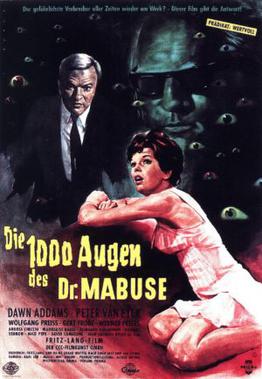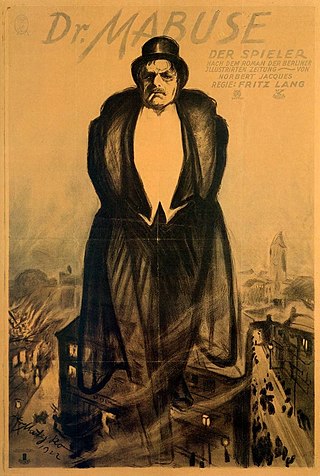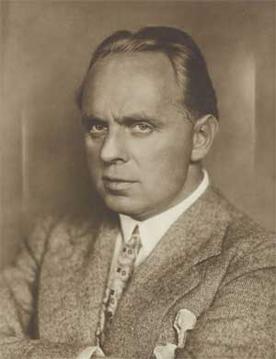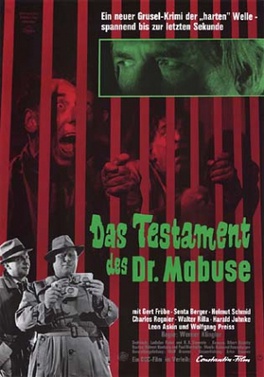
Friedrich Christian Anton Lang, better known as Fritz Lang, was an Austrian-US-German film director, screenwriter, and producer who worked in Germany and later the United States. One of the best-known émigrés from Germany's school of Expressionism, he was dubbed the "Master of Darkness" by the British Film Institute. He has been cited as one of the most influential filmmakers of all time.

Thea Gabriele von Harbou was a German screenwriter, novelist, film director, and actress. She is remembered as the screenwriter of the science fiction film classic Metropolis (1927) and for the 1925 novel on which it was based. von Harbou collaborated as a screenwriter with film director Fritz Lang, her husband, during the period of transition from silent to sound films.

The Testament of Dr. Mabuse, also called The Last Will of Dr. Mabuse, is a 1933 German crime-thriller film directed by Fritz Lang. The movie is a sequel to Lang's silent film Dr. Mabuse the Gambler (1922) and features many cast and crew members from Lang's previous films. Dr. Mabuse is in an insane asylum where he is found frantically writing his crime plans. When Mabuse's criminal plans begin to be implemented, Inspector Lohmann tries to find the solution with clues from gangster Thomas Kent, the institutionalized Hofmeister and Professor Baum who becomes obsessed with Dr. Mabuse.

The Thousand Eyes of Dr. Mabuse is a 1960 black-and-white crime thriller film directed by Fritz Lang in his final film. A West German/French/Italian international co-production, it starred Peter van Eyck, Dawn Addams and Gert Fröbe. The film made use of the character Dr. Mabuse, who had appeared in earlier films by Lang in 1922 and 1933. The Thousand Eyes of Dr. Mabuse spawned a film series of German Mabuse films that were released over the following years to compete with Rialto Film's Krimi films.

Dr. Mabuse the Gambler is the first film in the Dr. Mabuse series about the character Doctor Mabuse who featured in the novels of Norbert Jacques. It was directed by Fritz Lang and released in 1922. The film is silent and would be followed by the sound sequels The Testament of Dr. Mabuse (1933) and The Thousand Eyes of Dr. Mabuse (1960).

Spione is a 1928 German silent espionage thriller directed by Fritz Lang and co-written with his wife, Thea von Harbou, who also wrote a novel of the same name, published a year later. The film was Lang's penultimate silent film and the first for his own production company; Fritz Lang-Film GmbH. As in Lang's Mabuse films, Dr. Mabuse: The Gambler (1922) and The Testament of Dr. Mabuse (1933), Rudolf Klein-Rogge plays a master criminal aiming for world domination.

Otto Karl Robert Wernicke was a German actor. He is best known for his role as police inspector Karl Lohmann in the two Fritz Lang films M and The Testament of Dr. Mabuse.

Friedrich Rudolf Klein, better known as Rudolf Klein-Rogge, was a German film actor, best known for playing sinister figures in films in the 1920s and 1930s as well as being a mainstay in director Fritz Lang's Weimar-era films. He is probably best known in popular culture, particularly to English-speaking audiences, for playing the archetypal mad scientist role of C. A. Rotwang in Lang's Metropolis and as the criminal genius Doctor Mabuse. Klein-Rogge also appeared in several important French films in the late 1920s and early 1930s.

Artur "Atze" Brauner was a German film producer and entrepreneur of Polish origin. He produced more than 300 films from 1946.

Scotland Yard Hunts Dr. Mabuse or Scotland Yard vs. Dr Mabuse is a 1963 German crime film directed by Paul May and starring Peter van Eyck. Scotland Yard vs. Dr. Mabuse was distributed in West Germany by Gloria Film, premiering on 20 September 1963. The film was written by Ladislas Fodor, based on a story idea written by Bryan Edgar Wallace. It was shot at the Spandau Studios in Berlin. The film's sets were designed by the art directors Albrecht Hennings and Hans Kuhnert.

Norbert Jacques was a Luxembourgish novelist, journalist, screenwriter, and translator who wrote in German. He was born in Luxembourg-Eich, Luxembourg and died in Koblenz, West Germany. He created the character Dr. Mabuse, who was a feature of some of his novels. Dr. Mabuse, der Spieler, the first novel to feature Mabuse, was one of the bestsellers of its time; it sold over 500,000 copies in Germany. Today, Jacques is known best for Dr. Mabuse. In 1922, he received German citizenship.

Karl Adolf Kurt Werner Klingler was a German film director and actor. He directed 29 films between 1936 and 1968. He was born in Stuttgart and died in Berlin, Germany.

The Return of Doctor Mabuse is a 1961 black-and-white crime film/thriller made in West Berlin. It was a West German/French/Italian international co-production directed by Harald Reinl that was the second of the 1960s CCC Films Dr. Mabuse film series, being the sequel to Fritz Lang's The Thousand Eyes of Dr. Mabuse (1960). It starred Gert Fröbe, Daliah Lavi and in his first German film, Lex Barker. The film was co-written by Ladislas Fodor and in his first screenplay, Marc Behm who gives the film a science fictional plot that would be followed in the other films in the series.
"The Nine Lives of Dr. Mabuse" is the debut single by German new wave/synth-pop band Propaganda. The song was produced by Trevor Horn and was released on his label, ZTT in 1984. It appears on the debut album A Secret Wish. It was a moderate chart hit in the UK and Switzerland, peaking at numbers 27 and 14, respectively. In Germany, the song reached the top 10, peaking at No. 7.

The Testament of Dr. Mabuse is a 1962 German film directed by Werner Klingler. It was the fourth part of the Dr. Mabuse series from the 1960s and was a remake of the 1933 Fritz Lang film The Testament of Dr. Mabuse.














